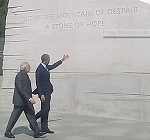The U.S. visit of Prime Minister Narendra Modi this past week, can be called a success. For Modi, because he reinforced his stature and legitimacy as a world leader with the largest ever democratic majority vote, and broadcast his own vision for India on a global stage. For his host U.S. President Barack Obama, embattled at home by partisan politics and abroad by an ill-advised foreign policy, the bilateral meeting was largely positive.
In short, the frayed friendship between India and the U.S. has been patched up. Now it’s time to put it to work.
Unlike the past mirage of great India-U.S. expectations, there seems to be a clear recognition of each others’ strengths and weaknesses.
And ever the pragmatic, Modi pin-pointed two existing strengths: a) working with the U.S. on India’s virtual infrastructure, and b) calling on the Non-Resident Indian community for a positive participation in India.
Both are at the stage of immediate take-off. India has long had its virtual infrastructure in place. Physical infrastructure — strangled by corruption, never really materialised, leaving all of India’s creativity to blossom in its virtual spaces. Satellite, Cellular and Software have been at the centre of our economic growth and societal change since 2000, creating the aspirations for young India. The recent successful Mangalyaan Mars mission has pushed us up a notch into a more sophisticated, science-driven satellite area: space. In this, the U.S. is in sync with us: its Mars Maven mission was almost synchronous with our own. The announcement of collaboration in space reflects the new, improved virtual co-operation — on that we believe can push trade to $1 trillion by 2030.
India’s Non-Resident Indians are also a continuum in the bilateral. They are both, Modi’s long-time supporters outside India, and the original links of the Bangalore-Silicon Valley connections. Indian-origin Valley techies and venture capitalists built on the Y2K platform, sparking the entrepreneurial culture of tech in India. Today, about one-third of Silicon Valley start-ups have an Indian co-founder. Bangalore has enough capital but not enough innovators, and as an investor said, “not enough success stories.” NRIs can help generate those innovators and successes.
At Madison Square Garden in New York, when Modi urged them to participate in India as tourists and investors, he was thinking both of Bangalore and of the Chinese example. Before the giant multinationals made South East Asia and China their global manufacturing base, the overseas Chinese community — particularly in the U.S., Hong Kong and Taiwan — had begun investing in China in large numbers. They were the interface to make China and its Communist government more scrutable to outside investors, and a pathway to China was built for the large western investors.
Modi’s easing of visa restrictions for U.S. citizens, both NRI and not, was an indication of his seriousness. He will be looking to the NRIs to move beyond small time bond, real estate and rupee arbitration and be patient investors in financing India’s virtual and physical infrastructure build-out. He will particularly encourage them to replicate, in India, the tech eco-system that makes the U.S. the world centre of innovation.
In the last five years, despite the financial crisis, the U.S. has produced the world’s most valuable companies: Google, Facebook, Apple, Twitter and more. All these have grown from a virtual space – the World Wide Web. India, in the same time, has created just one similar start-up, Flipkart, which is still dependent on both incomplete e-commerce laws and shabby physical infrastructure. The U.S., with its deep knowledge of these businesses, can help to upgrade our laws, systems, processes and education to embed these institutions. The innovation culture will surely spill over into the defence arena, further fortifying the partnership.
Then can the bilateral hope to operate as a partnership of equals, and move from the current indifference and irritability, to a true convergence of interests.
Manjeet Kripalani is the co-founder and executive director of Gateway House: Indian Council on Global Relations, Mumbai.
This article was first featured by The Asian Age in their Sunday edition.
For interview requests with the author, or for permission to republish, please contact Reetika Joshi at joshi.reetika@gatewayhouse.in or 022 22023371.
© Copyright 2014 Gateway House: Indian Council on Global Relations. All rights reserved. Any unauthorized copying or reproduction is strictly prohibited.


